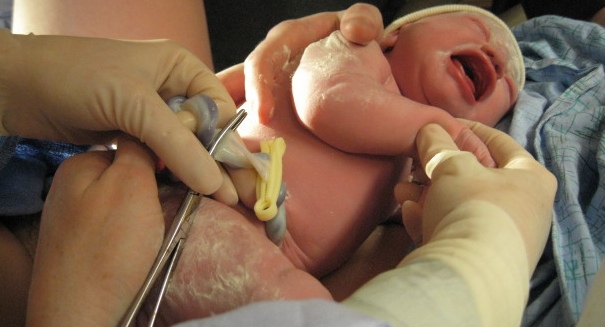
The World Health Organization also recommends delayed clamping. I
When a baby is born, the umbilical cord that connects the newborn to the mother is cut and clamped by the doctor. This procedure was one of the first routine medical practices associated with labor and delivery. However, there was no particular reason for its initial practice, but later research in the 1980s showed that it may reduce the risk of hemorrhage after labor.
Unfortunately, new research from the Cochrane Database of Systematic Review confirms scientists’ concerns that this practice may be overlooking potential benefits from delayed clamping. In 15 randomized trials involving 3,911 women and newborns, researchers found there was no significant difference in the risk to the mother or infant for bleeding after birth. On the contrary, there was evidence of benefits for the newborn in delaying clamping for one to three minutes. Benefits included increased iron reserves that continued up to six months after birth, increased early concentrations of hemoglobin, and a higher birthweight.
One of the risks that persists is the potential for the infant to become jaundiced. Waiting to clamp the umbilical cord can result in a loss of red blood cells, which can cause jaundice. It is actually common for jaundice to occur during the first five days of life and, in breastfed babies, can take up to three weeks to clear up. However, jaundice immediately after birth can signal liver trouble. Where the hospital or birthing facility is able to effectively diagnose and treat jaundice, delayed clamping may be appropriate.
The World Health Organization also recommends delayed clamping. In particular, where the infant will be living in an area that has less access to iron-rich foods, this practice may be particularly beneficial. Simultaneously, the doctors should be conducting routine, essential newborn care and not waiting until the cord is clamped to do so. Early clamping, which would occur in the first 60 seconds after birth, is only recommended by the World Health Organization where the newborn is asphyxiated and needs to be moved in order to be resuscitated.
The American Congress of Obstetricians and Gynecologists are cautious about the evidence, noting that it is insufficient to say either way if delayed clamping is beneficial. However, they do note that studies have shown evidence of other benefits to both the infant and the mother. Specifically, there is increased blood volume and corresponding reduced need for blood transfusion, as well as a decreased risk of intracranial or intraventricular bleeding.
Leave a Reply